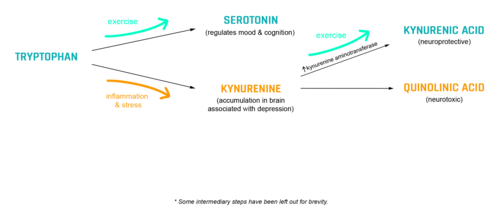Exercise and Mental Health
21-12-2019
Aerobic exercise can mitigate symptoms, facilitate recovery from, and prevent the relapse of mental health conditions.
We have more mental health dialogue than ever in modern society. It’s increasingly talked about openly amongst friends, especially with at risk groups such as young men.
I have been surprised by the number of mental health conversations I have had whilst out running and cycling. There is definitely a significant number of recreational athletes that use their passion to become more resilient to mental health setbacks.
Aerobic exercise can mitigate symptoms, facilitate recovery from, and prevent relapse of mental health conditions. This article will explore the myriad of ways that putting one foot in front of the other can do this. But first, let’s define our terms.
The Global Rise of Mental Health Conditions
Mental health is a broad topic.
In general we can say that positive mental health allows us to function in society, have meaningful relationships with those we love, energy to follow our passions, and hope for the future.
Conditions such as depression and anxiety can interfere with our ability to lead fulfilled lives. We can think of depression as profound sadness, fatigue, altered sleep and appetite, with feelings of guilt or low self worth. Anxiety can cause excessive fear of normal social situations, obsessive compulsive behaviours, distrust and inability to sustain relationships with others.
It’s important to note that mental health conditions lie on a spectrum. Feeling glum, sad, or nervous for a while is completely normal and part of experiencing a range of healthy human emotions. This is not the same as clinical depression which can involve changed hormone production, metabolic systems, inflammatory responses and immune functions. It can last months, years, or even a lifetime. This post is written in the hope that it is relevant to all people.
Mental health problems are not improving. Between 2005 and 2015 the rates of depression increased by more than 18%. The World Health Organisation currently estimates that 322 million people, 4% of the global population, are suffering with depression. As Stephen Fry rightly points out, this is not a case of 1st World Problems, the rates of mental health issues are similar across all wealth groups worldwide.
Those with mental health conditions suffer a range of other problems. Lower lifespan, obesity, addiction, and chronic health conditions are just a few.
Current treatments for depression include prescription drugs, especially SSRI’s (Selective Serotonin Reuptake Inhibitors). As Johann Hair points out in The Lost Connections, the evidence for the link between serotonin and depression is highly controversial. The response to treatment is variable and remission rates are high.
Prominent thinkers in the mental health field are now looking to alternative treatments for mental health conditions, such as diet and exercise.
Aerobic exercise can create drastic changes in people’s mood, recovery and resiliency to mental health conditions.
Exercise and Mental Health
Euphoria: Happy Molecules 😄
Oh the runners' high…….. That feeling of balance and total comfort in the world when you come back from a long workout.
There are two types of molecule that cause this euphoric feeling.
Cannabonoids are found both inside and outside of the body and are produced during aerobic exercise. Outside the body these molecules include THC and CBD, commonly found in marijuana. Inside the body they are called endocannabonoids They bind to receptors on cells throughout the body and in the brain, creating feelings of well being and reducing sensations of anxiety. They are produced spectacularly well between 70-80% of maximum heart rate, also correlated with zone 2 training.
Beta-endorphins are the other happy molecule. These bind to opioid receptors in cells, reduce stress and increase the body’s ability to maintain a positive internal environment. They help with the management of pain, as a reward to the body, and help maintain stable behaviour patterns.
It’s clear that endocannabinoids offer a short term fix which can be helpful for the management of mental health conditions. Beta endorphins support the body to maintain a productive metabolic environment and help to reward the body for maintaining stability in hormone levels. Taking control over your body and mind and keeping internal systems stable is a key element of recovering from mental health issues.
Body Temperature: Run Like The Finns Do Sauna, Or Ice Like The Iceman
People with depression have higher body temperatures on average. Anxiety can cause rapid fluctuations in body temperature that are difficult to control.
Lowering Body Temperature
For those with depression, it can be helpful to systematically lower the body temperature through exposure to higher temperatures.
A study has found that one dose of heat treatment in a sauna can help lower body temperatures as the body adapts. Participants in the study noted fewer symptoms of depression up to six weeks after only one exposure.
Exercise increases body temperature for short periods of time, and mimics how sauna was used in the study. I’d be very interested to see a study of aerobic exercise, long term body temperature changes and mental health.

Gaining Control of Body Temperature
It was previously thought that we were unable to control our autonomic nervous system. This regulates important bodily processes such as heart rate, digestion, respiratory rate, and urination. High heart rate, body temperature, digestive problems, rapid breathing, and frequent urination are all symptoms of anxiety.
Wim Hof, aka the Ice Man, has been using cold exposure to help him control his autonomic nervous system. He is able to control his own body temperature and immune system response through his practice of immersing himself in ice. So mindfulness during exposure to stressors on the autonomic nervous system can support the conscious control of body temperature, breathing rate, and heart rate.
When we exercise, we expose our body to stress on the autonomic nervous system like above. How much higher is your heart rate at races due to adrenaline and excitement? It’s possible to consciously lower that heart rate and perform better. For those that suffer from anxiety, aerobic exercise offers a pathway where we can learn to better control our autonomic nervous system and not be a slave to the fight or flight mechanism.
Stress and Inflammation: Removing Toxins and Protecting the Brain
Those with depression have a consistent level of low grade chronic inflammation. There is a clear link between the production of stress hormones, common in mental health conditions, and inflammation.
When we are not stressed and suffering from chronic inflammation, we are able to use a compound called tryptophan and convert it into serotonin. This is essential for regulating mood and cognition.
This is not what happens with those suffering from mental health conditions and inflammation. Instead, tryptophan converts into a substance called kynurenine and quinolinic acid, which is actually a neurotoxin. It causes the death and disease of brain cells and the normal functioning of the brain.
Aerobic exercise prevents the production of quinolinic acid and instead creates an enzyme that converts tryptophan to kynurenic acid. This is actually neuroprotective and supports the brain's normal functioning.

Running changes the way our body metabolises tryptophan. It prevents the production of toxins in the brain, and swaps it over for a substance which is protective.
Brain Health: Creating New Connections and Remodelling the Brain
Chronic inflammation is bad for the brain. It prevents the production of serotonin, but with exercise we can mitigate some of the effects.
Exercise produces short term acute inflammation which is different from this chronic inflammation. It actively supports the growth of new cells in the brain.
When we exercise, our muscles create myokines. These stimulate brain cells to produce molecules that support the healthy condition and production of more neutrons in the brain and are beneficial for the central nervous system. These are called neurotrophic factors. One example is BDNF (Brain Derived Neurotrophic Factor) that is produced through exercise. Those under high stress and those with clinical depression have less of this. Exercise can make up for that shortfall.
Creating new neutrons in the brain literally allows us the space to think differently. It opens up new avenues for self reflection and joins things together in ways we weren’t able to previously.
Suffering from mental health conditions can often feel like being stuck in a rut. You can’t escape negative thought patterns or the enduring mental and physical fatigue.
By creating substances like BDNF through exercise we can support psychological recovery and resilience.
Sleep: Restructuring The Circadian Rhythm
The circadian rhythm is our daily sleep and wake times, alongside our food intake and our peak productions of various stress hormones. Everyone is different, but those with depressive conditions often have disturbances in this sleep-wake cycle. They produce stress hormones at different times, and their internal clocks are often misaligned to light and darkness.
Exercise plays a strong role in the management of the circadian rhythm. Exercising at a similar time every day, alongside eating correctly, can promote the development of a strong sleep and waking cycle. Exercise also creates fatigue which supports healthy sleep patterns.
Timed exercise can help people sleep better and maintain a stable circadian rhythm. This helps keep the production of stress hormones consistent and support the better management of mental health symptoms.
Diet: Fuelling The Right Way
Diet has a huge role to play in the management, prevention, and treatment of mental health conditions.
Those that eat a standard Western diet with a high amount of processed food have higher risks of developing anxiety and depression, whereas those that eat more fruits and vegetables report higher levels of mental wellbeing.
Fried foods, alcohol, and high amounts of sugar all cause oxidative stress. These have been shown to prevent the production of new neurons in the brain. It’s difficult to recover from a mental health condition if you are unable to create neuronal pathways to think differently and make new connections.
When you exercise you quickly become attuned to what your body needs. It’s very hard to go for a run when you’ve just eaten McDonalds. When you come back from a workout your body wants fresh food, and if you don’t get the right nutrients you will soon learn that you can’t manage the fatigue.
Fasted training is a common form of training amongst recreational and elite athletes alike. It involves not eating for longer workouts in order to give more stimulus for improvement. I wrote an article about it here. This simulates so called intermittent fasting, where you don’t eat for a certain part of the day. There is considerable evidence that intermittent fasting can help with mental health conditions. These benefits could well apply to fasted training.
Exercising promotes eating a good diet, which can help with the production of new brain cells and heightened levels of mental wellbeing. Further, if you practice fasted training, there is some evidence that this will also help with symptoms.
Bridging The Gap: Disconnection From The Body and The Self
It’s hard to describe depersonalisation to someone that hasn’t experienced it. It is a condition that sometimes accompanies anxiety. It’s a detachment from the self; a feeling like you are just an observer of what’s happening around you rather than directly experiencing it. It is also a detachment from the body. You are unable to connect with your bodily processes and sensations can feel different or even totally numb.
People on the spectrum of mental health conditions can feel this in various ways. It is not uncommon for PTSD survivors to feel a disconnection from their body. Those that experience chronic stress are also unable to slow down for a period of time to check with how their body is feeling.
Exercise connects the mind and body. Through the repetitive motion of moving your entire self, you get an intimate knowledge of the bones, muscles and joints and how they are working together. Such small repetitive actions can be hypnotic and allow us to really feel what is going on inside.
Those that exercise come to fully understand their body under stress. They know when to push, when to hold back, how long they can hold certain efforts. They also know when to take it easy to avoid injury or when to push when the body is feeling good.
Such an intimate relationship with the body is the absolute opposite of what depersonalisation is. Exercise can help us regain control of the mind-body connection and counter symptoms of anxiety and chronic stress.
Nature Works
We are disconnected from the natural world.
I say that without the use of the words ‘some of us’.
Jobs which don’t allow us much daylight, use of electronic devices during recreational and social time, and children staying predominantly indoors is the norm.
Exercise creates the momentum to leave the house and experience the world around us.
It helps us foster a very intimate relationship with nature.
New routes are carved out in the landscape where every outing is a mini adventure. It’s a creative process. It’s a natural process. It’s something we’ve lost.
Spending time outside for therapeutic benefits is called ecotherapy. It improves mood, reduces feelings of stress or anger, and help you take time out to feel more relaxed. Giving time for yourself and your chosen method of exercise is giving you time to rebuild those energy reserves, ready to come back and face the issues that are present in daily life.
Getting outside can also help with Seasonal Affective Disorder by getting more light exposure. This also has the effect of keeping the circadian rhythm under control.

Joining The Community: Collaboration and Respect
Mental health issues can be isolating. It can be hard to create new relationships and maintain the ones you have. Feeling a lack of self worth, of being an annoyance or chore to be around, hinders people's ability to socialise effectively. This can exacerbate the issues surrounding the original problem.
Running and cycling clubs are everywhere. Almost all have an inclusive and barrier free entry policy. You can just turn up and spend time with kind people that are willing to support both in the sport and outside of it. Many have social events and maintain a big social group outside of the exercise focus.
It’s not just finding new friends but also the culture of respect and feeling of belonging to a club. There is something tribal about feeling supported and supporting others to do the thing they love.
Counteracting social isolation, feeling like you belong, and gaining respect from others are all key parts of maintaining positive mental health.

Being Heard: Talking With Movement
It can be hard to talk openly. When you are anxious of social situations it can be difficult to initiate a conversation, let alone have the enjoyable feeling of being in sync with someone and really getting along.
Exercising with other people takes the awkwardness away.
To begin with, you are all there with a mutual love of the same thing. You are also all moving together and focusing on something which is totally outside of the conversation. There is no judgement and barriers are dissolved. There are openers to conversation with talks about races, training methods and favourite places to go.
Once you’ve got the conversation started, it is amazing how many people are actually open to discussing mental health challenges. A lot of people with mental health issues use exercise in the ways outlined above. You will find people from all walks of life, experiencing life’s most difficult challenges. You can talk about your own experience, and learn so much from the experiences of others.
Being heard and learning from others are skills that can be developed and can be transferred to other areas of life. Other social avenues can open up and new connections can be made.
Self Improvement: Getting Stronger In Both Body And Mind
Many mental health conditions can feel as if they are static and just aren’t improving. It’s hard to see the incremental improvements one can make. The ups and downs of recovering from a mental illness are hard to put into a structure where you can see a trajectory to feeling better.
With exercise you can see notable improvements straight away.
Exercise gets easier very quickly once you get started. Within weeks you feel a difference in fitness.
Your body changes as you lose weight and gain muscle mass.
Your resting heart rate lowers and daily activities become easier.
This momentum can help to think more about the mental health journey. Setting goals and seeing progress are a huge part of recovery from mental illness and also a way of maintaining positive mental health.
With aerobic exercise, there is the concept of periodisation. This means having harder workouts followed by easier ones which allow your body to recover. Using this concept outside of training is a real skill. If you have a hard day at work one day, consider going easier the next day to allow yourself to recover. If you had some triggers for anxiety one day and successfully overcame them, congratulate yourself and reduce your exposure to the same amount of triggers the next day. Actively planning your mental health recovery and management is essential for long term success.
Think of mental health recovery like training. You need to stress your body in just the right amounts to see improvements. This is called progressive overload. As you continue to add more stress, you will be able to cope with more. This will make you stronger and reinforce any mental health strategies you have.

Conclusion
If you are suffering from a mental health condition, it’s important that you speak to your GP or health practitioner and get in touch with those that love and support you. Nothing said in this article can replace those two hugely important factors.
I also don’t want to suggest that prescription medication doesn’t have a place. It definitely does and for some people it works wonders.
I do feel that exercise is looked down upon as a ‘soft’ treatment option. But the science is there to support the metabolic changes it fosters, as well as the improvements in feelings of community integration and self development. It’s one tool in a big arsenal for combatting mental health conditions and fostering positive mental wellbeing.



